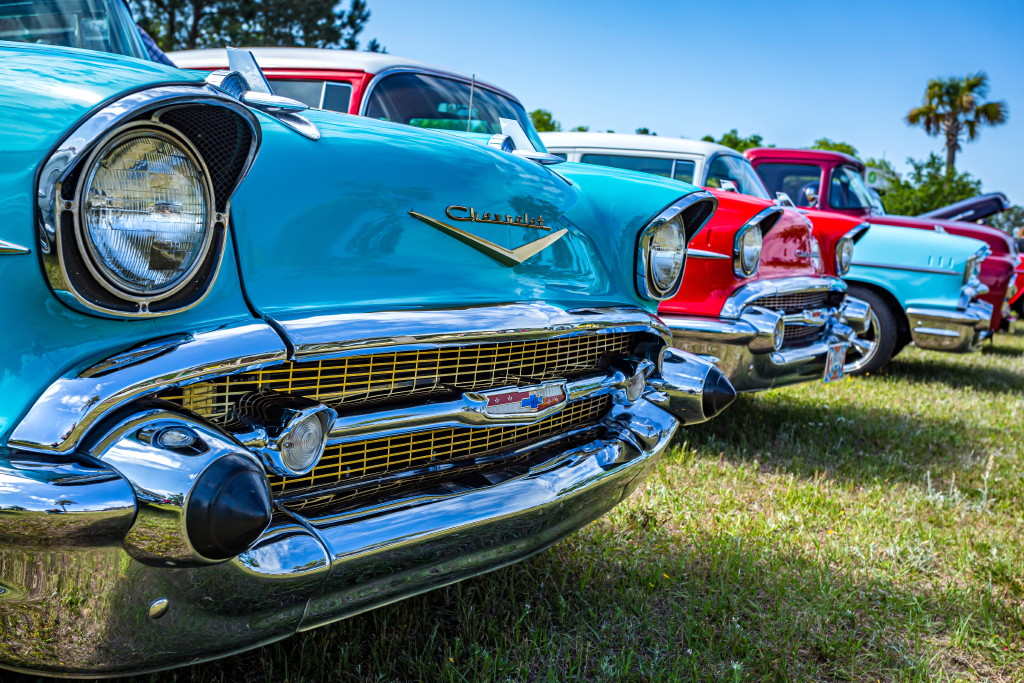Freedom And Fun On The Open Road
By David Cohea, ReMIND Magazine
Friday night, end of the school week and off-shift at the factory, teens across America piled into their cars to cruise downtowns big and small — from Stockton to Wilkes-Barre, Rapid City to Macon.
When we imagine the year 1961, the rearview mirror fills with Bel-Airs and Impalas, Ramblers and DeSotos, lined up and revving for another night of freedom on the road.
In the early 1950s, America transitioned from a wartime to a consumer economy. The GI Bill had made home ownership affordable for veterans and resulted in a baby boom, with 4 million babies born every year that decade. Suburbs sprouted up everywhere, with millions commuting to work. Some 54 million cars were produced and sold during the 1950s by the American manufacturers.
“America’s love affair with the automobile” was made official when Groucho Marx declared it in a 1961 TV documentary titled Merrily We Roll Along, sponsored by DuPont (then a 23% shareholder of General Motors). Groucho told the story of cars in America, ending his tale while driving a convertible down the highway. “Wherever we are headed now, it will be in something like this,” he proclaimed.
Sixty years later, he’s still right.
The car became a symbol of suburban affluence great enough even for teens to own their own cars (or borrow Dad’s). Teens took to cars in droves. A driver’s license exam became the ultimate rite of passage to a set of car keys and the open road.
With cash in pocket from allowances and jobs, the auto cavalcade of teen drivers on weekend nights was endless. Cruising usually involved driving down Main Street, showing off one’s wheels, cranking tunes on the radio and checking out the girls. Groups of girls eventually took up the cruising ritual as well.
While drag racing was discouraged by law enforcement, most turned a blind eye to other cruising entertainments like mooning and pranks, like “fire drills,” where occupants of a car would get out and run around the car when it was stopped at a light then get back in.
Popular music was changing to fit car radios. In 1961 you’d be likely to hear “Wheels” by the String-A-Longs (1960), “Stick Shift” by the Duals (1961) or “Beep Beep” by the Playmates (1958).
Drive-in burger joints became popular, with orders called in from the car and food delivered to trays perched on the rolled-down car windows. Wait staff frequently hurried food from grill to car on roller skates.
Another sure destination was the drive-in movie. In 1958, the number of drive-in theaters peaked at 4,000, which meant there was plenty of gawking and eating and necking to be had in just about every burg.
Up on the screen there were plenty of sci-fi double features, but car dreams also fed the teenage imagination in movies like The Fast and the Furious (1954) and Thunder Road (1958). The “chicken drag race” at the end of Rebel Without a Cause (1955) would be repeated with a sanitized conclusion 18 years later in American Graffiti.
Hot rodding appealed at the outer edges where greaser rock ‘n’ rollers combed their pompadours. But for the majority of teen drivers who played it safe, there still was the thrill of gunning the engine, waiting for a red light to turn.
Cruising declined in the ’70s with rising gas prices and stricter law enforcement less tolerant of teen cruising. Cruisers would move on to another strip where eventually they would be chased off as well.
With all the new electronic devices to flood the market, teens became more limited in their car purchases. Now the freedom of the road has been digitized into the virtual vastness of cyberspace.
Cruising festivals, however, can still be found around the country. Detroit’s northern suburbs still host the Woodward Dream Cruise, attracting more than a million visitors and some 40,000 muscle cars, street rods and custom vehicles. And in Modesto, California, the town celebrates an annual Graffiti Summer cruise down 10th and 11th streets, where the film American Graffiti is set.
But back in 1961, cruising was another Friday night ambling down Main Street with everyone else and a world of possibility idling up to you at the next stop light.




